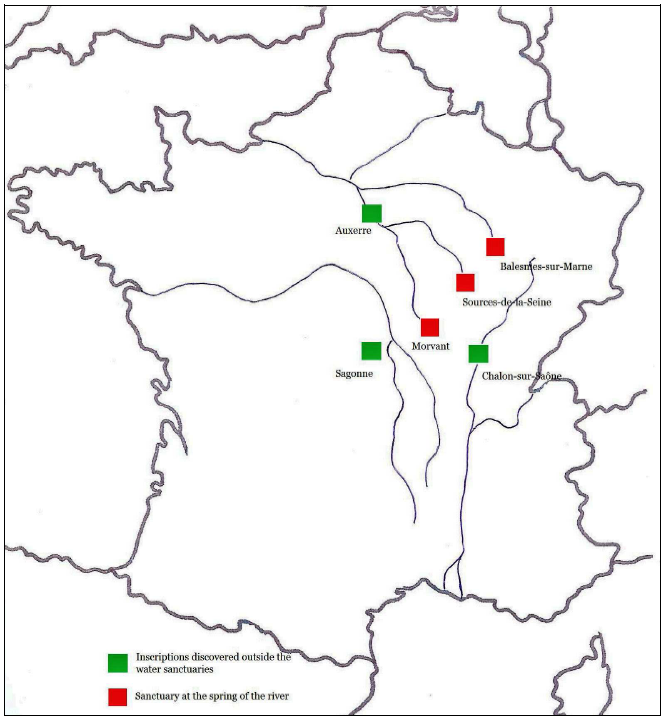4) The River Yonne: Icauni
The ancient name of the River Yonne, which rises on Mont Préneley (Nièvre) and meets the River Seine at Montereau-Fault-Yonne (Seine-et-Marne), was revealed by a 2nd-century AD inscription dedicated to the goddess Icauni, discovered in Auxerre (Yonne). The name of the river then evolved to Ingauna in the 6th c., Iona in the 9th c., Ycauna in the 12th c. and Iuna / Yconiae in the 13th c.1891
The inscription, which is now lost, was engraved on a square altar. It was discovered in 1721 in re-employment* in the ancient wall of the city Auxerre (Yonne).1892The inscription reads: Aug(usto) sacr(um) deae Icauni T(itus) Tetricius African(us) d(e) s(uo) d(edit) d(edicavit), ‘Sacred to Augustus, to the goddess Icauni, Titus Tetricus Africanus dedicated and offered (this stele*) at his own expense’. The dedicator bears Latin names and the tria nomina of Roman citizens. In 1723, Abbot Jean Lebeuf reported that a relief* representing a woman lying down had been seen by former neighbours near the place where the inscription was inlaid, but the drawing no longer existed at the time of the discovery of the dedication.1893 As reclining naked women are commonplace representations of river-goddesses, this relief* may have been a figuration of the goddess Icauni.
The significance of the name of Icauni is unknown. Jullian explains that it may be based on a Gaulish root *ico, possibly similar to Latin aquae, meaning ‘water’, ‘river’.1894 Icauni could then be etymologically related to the goddess Icovellauna, venerated in Metz (see infra). There is besides an Istrian goddess of springs and fountains named Ica or Ika, attested near Fianona and Lovran (Croatia).1895Following this etymology*, Lacroix proposes to break down her name as *(s)ic-auna, i.e. ‘The One who gives Water’ and argues that Delamarre’s etymology* *(s)(p)ico- designating the ‘green woodpecker’ is highly unlikely.1896 According to him, the radical *(s)ic- is to be related to the radical sec- forming the name of Sequana (*Sec-u-ana) and the radical souc-, a possible variant of suk-, found in the name of Souconna.1897 Icauni would have originally designated the spring gushing from the earth rather than the flowing water of the river.1898
Excavations carried out from 1980 to 1984 at the spring of the River Yonne, at Glux, in Morvant (Nièvre), revealed the ruins of two Gallo-Roman temples, situated about a hundred metres from the three springs of the river.1899 The archaeologists did not find any pipes channelling the waters of the river into the buildings, but the proximity of the monuments with the springs undeniably proves that they were erected in relation with it. Pieces of broken Gaulish vases and fifteen Gaulish coins, such as a coin in silver of the Aedui, were found within a radius of one kilometre. This provides evidence that Celtic people already frequented this place of devotion before the Roman invasion. It is likely that the Gallo-Roman monument was built over an ancient Celtic place of worship, marked out by an offering well or by a wooden fence. In view of the sanctuaries of the goddess Sequana unearthed at the Sources-de-la Seine and of Matrona at the spring of the River Marne, it is tempting to think that this shrine was dedicated to the goddess of the River Yonne, whose existence is attested by the inscription from Auxerre. The waters of the River Yonne were perhaps believed to have medicinal virtues like those of the River Seine and attracted pilgrims in need of care, but no archaeological evidence, such as votive inscriptions, anatomic ex-votos* or other offerings, currently supports that theory.1900
